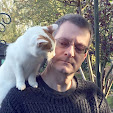Obviously settings are to each persons' taste but I have never quite got on with all the Blender defaults. I assume when using a new programme that the authors know better than me what are the best settings for their application. Eventually I give up and use my own choice.
Rotation
The default rotation type of Turntable is fine but it pivots round a hard to understand global point. It almost feels arbitrary to me.
Zoom
This is just my preference. By default Blender zooms to the centre of the current view. Sometimes that is OK but I find it quicker to zoom to where my mouse is pointing.
Metric
I like to work with actual sizes and I like those to be metric.
Ideally millimeters (mm) but although Blender allows entering numbers as mm, it displays the results in centimeters (cm).
I use the scale option to get the result to be mm. One unit size equals 1mm.
I am sure that most readers will assume that my preference for metric is because I have grown up in England. This is not entirely the case. I am old enough that I can work in both imperial and metric and I do still measure in inches when working on less precise jobs, like fences for the fields. When I'm 3D modelling, I typically need some accuracy and millimeters is just so much easier at all scales.
I can't complain because I still prefer working in degrees and not radians but clearly Blender's interface is designed for the units most commonly used in Europe and not for people like me and most of the building trade in the UK that work in the scientific standard size of millimeters. I am happy there is a choice and centimeters are much better for my needs than inches.
Display
The information I display while working changes. It is handy to hide bits so they do not get in the way.
The things I find useful are the lengths of selected edges to get accurate sized objects and the normals to show the outside face of a surface.
I also turn on back face culling to help with keeping track of the outside and inside of objects.
As I find other preferences, I'll update this page.




















